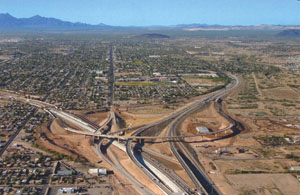
If the flows were too fast, sediment would be brought into the trenches and hinder flow. The steady flow rates ensured that the irrigation system would function correctly. By reducing the channel size as the flow decreased, the Hohokam were able to sustain a steady flow rate throughout the different branches of the system. The main channels, which drew water directly from the river, were wide at their mouths and tapered as secondary branches drew water from the main channel. The trenches were dug 12 feet deep and diverted water from the Salt and Gila Rivers. The irrigation system is simple, but the true marvel of its creation is its monumental scale. The Hohokam canals built in the Mesa area as long ago as 600 CE are still considered engineering marvels. The canals the Paleoindians and early Hohokam built in the Santa Cruz Valley prefigured the complex networks that the Hohokam built in Central Arizona nearly 2,000 years later. The Hohokam method of irrigation was unparalleled anywhere else in the Southwest. Archaeologists point to this time as the moment when a culture formed that could distinctly be labeled Hohokam. Scholars have posited that as culture flourished and the Early Agricultural Period came to a close, distinct identities began to appear among the Paleoindians. There is evidence of trade with neighboring tribes and even with peoples as far as Mesoamerica. At the site at Sunset Road, the technological advances of the early Santa Cruz societies can be seen. Other aspects of culture advanced as a result of this expanded wealth. Populations boomed, and settlements expanded into villages and harnessed resources from a greater area. Eventually, multiple family groups began to settle together. At settlements along the Santa Cruz River, people grew corn, squash, and beans to supplement existing hunting and trapping. During this period, societies moved towards larger permanent settlements and increased prosperity. Sunset Road acts as a lens into a transitional period for the Santa Cruz peoples. The discovery made there is the earliest evidence of the use of irrigation in the Santa Cruz Valley. Bahe, of Navajo descent, brought his daughter to the site, which provides a 3,000-year-old snapshot of the life of these early farmers. For Native Americans, the site represents a medium to establish a relationship with their ancestry. The rest of the site was excavated to reveal an ancient agricultural field with multiple sets of footprints, field boundaries, planting pits, and irrigation canals.Īccording to McNamara, these findings were more than just a glimpse into history for Jason Bahe, Pima County Department of Transportation project manager. The prints belonged to ancient farmers who had tended to fields along the Santa Cruz River, which is thought to have existed up to a mile away from its current location.

He slowly uncovered the rest of the print to reveal the toes and eventually a set of human footprints. As Patrick McNamara described in the Tucson Daily Star, the excavator, Dan Arnit, gently scratched away at the dirt, revealing what looked to him to be a heel. A worker excavating at the site of a planned bridge made an astounding discovery. Nearly two years ago, construction began to connect West Sunset Road with I-10 and North Silverbell Road.

Evidence suggests that it was farmed extensively in the Early Agricultural Period, roughly 2,000 - 3,000 years ago. The Tucson area is known to have been an important agricultural hub for ancient Native American tribes, and the Santa Cruz River floodplain contains the earliest recorded instances of irrigation in the Southwest. These discoveries could potentially alter how archaeologists view the technological progression of the region’s earliest inhabitants. Around 4,000 prehistoric sites have been identified in the Santa Cruz watershed and exciting new discoveries continue to be made. The Clovis culture is generally regarded by archaeologists to be the ancestors of most Native American tribes. The earliest evidence of human occupation dates back 12,000 years, prior to the existence of the Clovis peoples. In fact, the Santa Cruz River Valley is one of North America’s longest inhabited regions. However, Tucson can also be associated with a rich history dating back to the earliest Southwest Paleoindians. When people think of Tucson, Arizona, they typically think of our scorching hot summers or the highly-regarded University of Arizona.


 0 kommentar(er)
0 kommentar(er)
